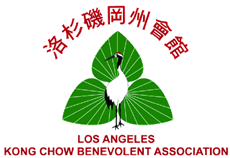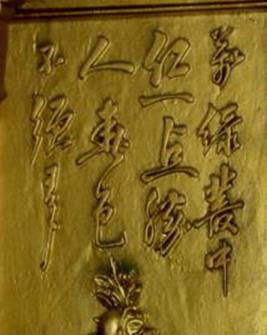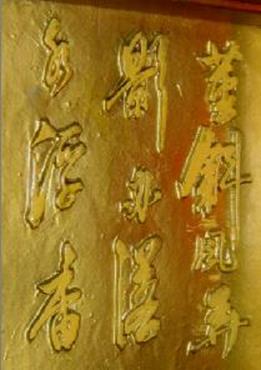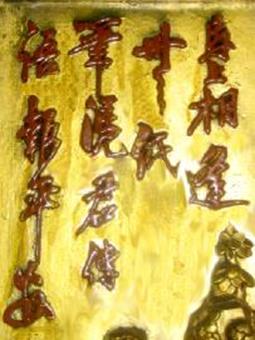





|
KONG CHOW BENEVOLENT ASSOCIATION OF LOS ANGELES, A NON-PROFIT CHARITABLE CORPORATION |






|
“Red dot amongst seas of green; Beautiful scene needs not be more ” |

|
A Glimpse of the Pass of Kong Chow Benevolent Association and the Old Temple By Ronald Wong, late Advisor and member of Board of Directors |
|
It is interesting to trace the historical facts of "Kong Chow". The character "Chow" signifies itself as an official name of a large county first given a title a little over 13 centuries ago (around about 600 A.D.). It was situated in the south-western part of the Kwongtung Province, which was conquered by an army of 50,000 under the order of the Emperor Chin who built the Great Wall. He divided it into three counties; one of these was Nam Hoi from which San Wui County was ceded. During the Chui Dynasty, the name was abolished. A new title "Kong Chow" was given to it by the first ruler of the dynasty. The new name was used for nearly three hundred years until it was subdivided into four districts which we call "Yups" nowadays. Since the system of classifying the imperial kingdom varied from reign to reign; that vast extent of fertile land undoubtedly had undergone many title changes. Consequently, the name Kong Chow was never in use again. From 1709-1722 A.D., revolts began to take place. This was on account of poor communication in those days and the fact that the imperial soldiers could not garrison in every district that one of the four "Yups" or Districts, San Wui (formerly the general name like Kong Chow, of the whole county now turned out to be one of the four Yups) was divided into two districts. This made a total of five Yups. Each Yup consists of many villages, that carry different family names. It has been a thousand years ever since the name Kong Chow was abolished, yet the people originated within the range of Kong Chow are just like members of a big family, keeping the same traditions and customs, although the dialects of the 5 districts vary a little from one another. Indeed, they are brothers, and brothers within the Four Seas. Our benevolent association bears the name Kong Chow is in memory of this old place. The association was first founded in 1849 in San Francisco as Four Yups Association, and was later changed to Kong Chow Benevolent Association in 1851. All people originated from Kong Chow were entitled to be members. In 1854, the population of the Four Yups increased so fast that they claimed to be independent and soon formed their own organizations. Some members were influenced by the separation and soon followed their footsteps, and thus put an end to the main association under which all the other "Yups" were primarily organized. However, San Wui and Hork San still band together. They reinstituted Kong Chow Benevolent Association as a mutual body using the same site of the main association. This went on smoothly under the supervision and guidance of a few philanthropists and prosperous merchants for many years. Unfortunately in 1906, a big earthquake caused the Great Fire in San Francisco, the building of the association was entirely burned down. Two years later (1908), a new, beautiful building of three stories was once again erected. At its main entrance, there was a big rectangular wooden token hung against the wall. Four Chinese characters meaning "The Forerunners of Chinese Americans" were carved on it. These characters were written by the first Chinese student who studied in the States. The third floor of the building was used as the Kong Chow Temple, honoring the Red Faced Warrior who lived during the Three Kingdoms period. Forty five years ago, the building of the association was completely renovated, and still functions as the grand lodge of all the Kong Chow sub-associations in the States. Kong Chow Benevolent Association is a benevolent organization. One of its many functions is to help the aged, desolate and sick members besides evoking other social welfare bodies. It used to be the responsibility of the association to have the remains of its members shipped back to China for interment. As a fraternity and sorority, it is a place for social gathering. The purpose is to develop better understanding, mutual interests and esteem among the Chinese community. Nevertheless, the virtue of arbitration still plays an important part in its routine. Faith and philosophy, which are rather conspicuous among our Chinese public; as a matter of fact, are the two striking factors, together with our deep-rooted culture that enable us to attain a renown of high morality, which is simply the practice of the duties of life. Although a great many of us have been influenced by the western culture, some still prefer our own perpetual belief. The Red Faced Warrior in the Kong Chow Temple is regarded and honored as a god* whose titanic spirits of righteousness .. …… TO READ MORE |
|
華人移居海外可遠朔至唐代。但在十九世紀中,在滿清腐敗,列強入侵等因素下,到美國謀生者日漸增加。 早期美國的華人主要來自閩粵兩省,尤其是的「古岡州」 地區:包括新會、鶴山、台山(或新寧)、開平、恩平五邑的百姓。他們就成了人們心目中的典型中國人。回鄉時,大家都尊稱他們做「金山伯」。 華人移居海外雖然解決了溫飽的問題,但他們心繫祖國,惦記親人,盼望團聚的願望卻與日俱增。許多時候,」… . |
|
|
|
The Ancient Kong Chow Temple A discussion on the spirit of the pioneers By Kwan Ming Chan and Karen Chan
The early history of Kong Chow in Los Angeles – the “Golden Mountain Uncle”
Los Angeles is a major metropolitan city along the West Coast of USA. Besides the world-famous Universal Studio and Disneyland, the city has the most busy freeway system and the harbors with the highest loading volume of containers cargoes. The ethnic diversity of residents has made the city a renowned “global village”. There are numerous ethnic districts, whereas the Chinatown is the best well known one………… To read more |
|
“Branches bend with shadows cast by wind ; Petals fallen on water float with fragrance” |

|
“Riding on horse back without paper nor pen; Relying on you to inform words of safe and sound” |

|
Home | About Us | Contact Us | Events | Kong Chow Temple |


|
|